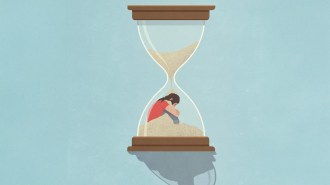Social judgments take touching turns
Tactile sensations can sway people’s negotiating tactics and first impressions
Don’t be shocked if car sellers soon decide to seat prospective buyers in beanbag chairs, or maybe in La-Z-Boys. Soft seats subtly steer people away from driving hard bargains, a provocative new study suggests.
Objects’ tactile qualities, such as a chair’s softness or hardness, automatically call to mind associated metaphors, such as flexibility or rigidity, say MIT psychologist Joshua Ackerman and his colleagues. In this way, sensations of weight, texture and hardness surreptitiously create mindsets that influence how people think about and deal with others, the researchers propose in the June 25 Science.
The team conducted six experiments in which people, some passersby on streets and some volunteers in a lab, experienced different touch sensations while making several kinds of decisions. In one case, 43 people sitting in hard wooden chairs showed less willingness to compromise in price negotiations for a new car than 43 people who sat in cushioned chairs. After being told that their initial offer on a car with a $16,500 sticker price had been refused, wooden-chair sitters upped their offers by an average of $897, compared with $1,244 for the cushioned crowd.
In other words, people in soft chairs increased their offers 38% more than people in hard chairs.
“I suspect that the stresses of real-world decision-making environments will act as mental distracters, making people even more susceptible to the effects of tactile cues,” Ackerman says.
Studies of how touch affects real-world decisions will be crucial, comments psychologist L. Elizabeth Crawford of the University of Richmond in Virginia. “I would guess that these effects are more subtle than will be appreciated by the marketers who will try to implement them,” she says.
A tendency for supple seats to soften up price negotiators aligns with research suggesting that bodily experiences often lie at the root of how people think (SN: 10/25/08, p. 24). To determine if hard chairs served as a mental metaphor for hard bargains, though, researchers need to confirm that low offers from people sitting on cushioned chairs relate directly to sensations of softness, not simply to physical comfort, Crawford notes.
In another experiment conducted by Ackerman’s group, 54 passersby evaluated a job candidate by reviewing the same resume attached either to a light or a heavy clipboard of the same size. Light clipboards weighed about 340 grams, or 12 ounces. Heavy clipboards weighed just over 2 kilograms, or 4.5 pounds.
Volunteers who hefted a heavy clipboard rated the job applicant as being especially serious about the position, consistent with that clipboard having triggered metaphorical associations with heaviness. Heavy- and light-clipboard users agreed on the job candidate’s likability and cooperativeness, traits unrelated to weight metaphors.
In another clipboard test, 21 men who completed a “social action survey” allocated more government money to various public issues — including education and postal workers’ salaries — if they held heavy clipboards. Comparably high rates of funding for these issues were endorsed by the 22 women surveyed, regardless of clipboard weight.
Another 42 passersby assembled a jigsaw puzzle with five pieces that were either smooth or covered in rough sandpaper. Each volunteer then received 10 tickets for a $50 lottery and had to decide how many tickets to give to an anonymous partner, who could reject the deal and leave both parties ticketless.
People who handled rough puzzle pieces offered an average of about four tickets, versus three for those who used smooth pieces. That disparity reflects a stronger expectation among volunteers who touched rough pieces of dealing with a demanding partner, Ackerman suggests.
“For salespeople and those who do a good deal of handshaking, if the situation calls for social coordination, it may be worth it to get a manicure and smooth things out,” comments psychologist Lawrence Williams of the University of Colorado at Boulder.
Overall, the experiments underscore an intimate link between body and mind, he adds. Physical concepts such as roughness and hardness are among the first that young children grasp. These basic concepts lay the groundwork for developing abstract concepts about people and relationships, such as notions of a rough patch and a hard heart. By adulthood, tactile concepts and related metaphorical concepts become closely associated in people’s minds, Ackerman hypothesizes.







